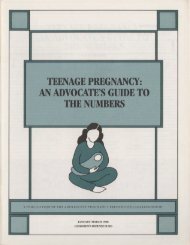child care - Digital Library Collections
child care - Digital Library Collections
child care - Digital Library Collections
You also want an ePaper? Increase the reach of your titles
YUMPU automatically turns print PDFs into web optimized ePapers that Google loves.
THE STATE OF AMERICA'S CHILDREN YEARBOOK 1998<br />
tice, and mental health systems were struggling to<br />
<strong>care</strong> for many of the same <strong>child</strong>ren, federal and<br />
state policies seldom promoted interagency approaches,<br />
nor was community participation emphasized.<br />
Service systems did not comprehensively<br />
address the needs of individual <strong>child</strong>ren and<br />
families.<br />
The Child and Adolescent Service System Program<br />
(CASSP), begun in 1983 with a $1.5 million<br />
budget, was the fIrst initiative focused exclusively<br />
on improving the coordination of service agencies<br />
for <strong>child</strong>ren and teens with serious emotional disturbances.<br />
As funding grew, services expanded, but<br />
the principle of partnering with agencies, parents,<br />
and others working for <strong>child</strong>ren remained key. The<br />
1993 Family Preservation and Support Services<br />
Program also required states to bring together<br />
these kinds of partners to identify existing supports<br />
and needs for <strong>child</strong>ren and families and to plan for<br />
the use of new resources.<br />
Families in Crisis: The Scope<br />
of the Problem Today<br />
Asurvey of state <strong>child</strong> protection agencies in<br />
1996 by the National Committee to Prevent<br />
Child Abuse reported 969,000 <strong>child</strong>ren abused<br />
and neglected. However, some experts believe that<br />
as many as three times that number need help.<br />
Indeed, 3.1 million <strong>child</strong>ren were reported abused<br />
and neglected to public <strong>child</strong> protection agencies,<br />
and a national incidence study that gathered data<br />
from additional sources suggested that actual victims<br />
may have numbered 2.8 million <strong>child</strong>ren in<br />
1993.<br />
The American Public Welfare Association estimates<br />
that 502,000 <strong>child</strong>ren were in foster <strong>care</strong> on<br />
an average day in 1996-about 25 percent more<br />
than in 1990. Although a current national profJJe<br />
of these <strong>child</strong>ren does not exist, an interesting picture<br />
emerges from the 1997 Multistate Foster Care<br />
Data Archive's examination of placement patterns<br />
in six states (accounting for about half of all <strong>child</strong>ren<br />
in foster <strong>care</strong>) from 1983 to 1994. The most<br />
recent growth in foster <strong>care</strong> placements primarily<br />
involved <strong>child</strong>ren placed with relatives. The study<br />
also found infants and young <strong>child</strong>ren entering foster<br />
<strong>care</strong> in greater numbers than any other age<br />
group and remaining in <strong>care</strong> longer than older<br />
<strong>child</strong>ren.<br />
Of particular concern are <strong>child</strong>ren who become<br />
long-term clients ofthe <strong>child</strong> welfare system.<br />
Most reunification of <strong>child</strong>ren with their families<br />
occurs within two years of a <strong>child</strong>'s entry into foster<br />
<strong>care</strong>, but more than one-third spend much<br />
longer periods in <strong>care</strong> (see figure 5.2). Reentry into<br />
<strong>care</strong> is a problem too. Of the <strong>child</strong>ren who entered<br />
<strong>care</strong> in 1988, about 20 percent returned within fIve<br />
years.<br />
Children with serious emotional problems,<br />
whose special needs too often go unmet and who<br />
may be at great risk of entering foster <strong>care</strong>, are<br />
another concern. The Center for Mental Health<br />
Services in the U.S. Department of Health and<br />
Human Services (HHS) announced in 1997 that<br />
between 3.5 million and 4 million <strong>child</strong>ren ages<br />
9-17 have a serious emotional disturbance. The<br />
center also reported that emotional problems are<br />
especially prevalent among poor <strong>child</strong>ren. It has<br />
published estimates ofthe number of<strong>child</strong>ren with<br />
emotional disturbances in each state, based partly<br />
on the <strong>child</strong> poverty rate in the state.<br />
Promoting Adoption and Other<br />
Permanency Options<br />
In 1997 considerable attention was paid to providing<br />
permanent families for <strong>child</strong>ren, particularly<br />
the 100,000 <strong>child</strong>ren living in foster homes<br />
and group <strong>care</strong> settings who cannot return safely to<br />
their birth families.<br />
Federal and state action. Last year the HHS<br />
secretary, responding to a December 1996 presidential<br />
directive, announced a plan to double the<br />
numbers of adoptions and other permanent placements<br />
for foster <strong>child</strong>ren by 2002. Congress also<br />
took action with passage of the Adoption and Safe<br />
Families Act. Signed into law by the President in<br />
November 1997, the act includes numerous provisions<br />
developed with bipartisan support that are<br />
intended to promote adoptions for <strong>child</strong>ren waiting<br />
66 CHI L D R E 'S D E F ESE F U D














